-
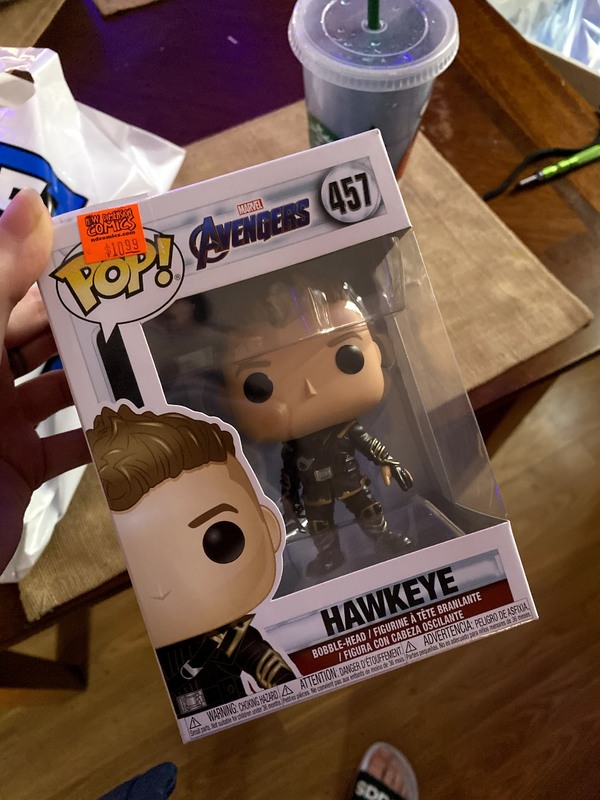
2021-04-07
My dad is a paramedic currently working three jobs within the EMS field. He's basically only home one day out of the week. I take care of the house and my little sister while he's gone but I know the job is hard right now, especially with Covid-19. When I can, I buy him little gifts I think he would appreciate, like this Hawkeye Funko Pop. I honestly just wish they would pay paramedics and other EMS related first responders more than what they get now, especially since this pandemic has shown how necessary and essential their job is.
-

2021-03-21
Banksy will donate the hammer price of £14.4m to help support health organisations and charities across the UK that enhance the NHS’s care and treatment. Christie’s Auction House will “donate a significant portion of the Buyer’s Premium to these causes” too.
The Game Changer canvas first appeared in May 2020 at the University Hospital Southampton as a thank you to all the staff and NHS workers across the country during the first wave of the Covid-19 pandemic.
The black and white artwork shows a little boy playing with a superhero nurse whilst Batman and Spiderman’s usual heroes are now in the trash.
A reproduction of Game Changer will remain on view at University Hospital Southampton hospital.
-
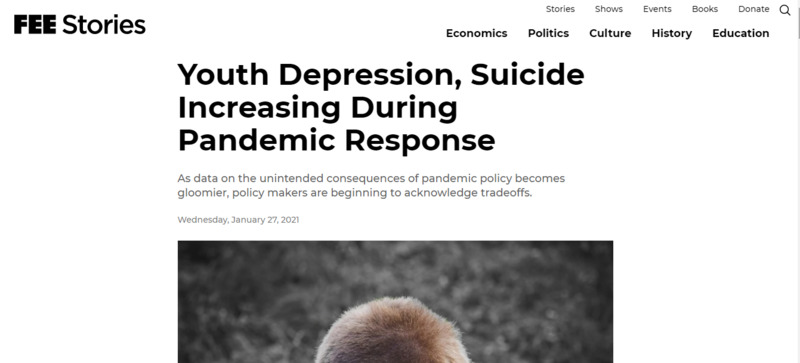
2021-01-27
This article tells about youth depression and suicide rates in the United States and how they have been affected by the COVID-19 pandemic. Children and teenagers, who are normally bright-eyed, idealistic, and sometimes too socially adept for their own good, are developing mental afflictions like depression and suicidal ideation, using drugs and alcohol as coping mechanisms, and generally suffering from all sorts of silent illnesses because of lockdown policies that have deprived them of the activities that keep them busy. When a kid has a busy life, friends at school, activities they enjoy, and various tasks to perform in order to keep their minds occupied, they turn out to be a well-balanced, healthy adult later in life. However, when every single one of these things is abruptly stripped from and the only type of structured activity they have is getting on the computer every day for “Zoom school” (which, by what I have been told by teenagers currently experiencing it, is a poorly-planned waste of time put on for show), the affect on that child’s mental health can be catastrophic. The overdramatic teenage mind will tend to think that this period is going to last “forever,” leading to a downward spiral of emotional despair and existential nihilism. Furthermore, the financial strain that the pandemic has put on these kids’ parents surely plays into this as well, making the child feel like a burden since they have to sit at home all day and watch their parents worry about the family’s financial situation. While high-income individuals with significant savings got to have lots of fun on their cute little house-camping quarantine adventure, low-income and middle-class households, the ones with the most children, had to suffer and pay a serious price for something the government decided they would do. This general phenomenon of depression, financial worries, nihilism, drug abuse, and suicide is a direct result of government lockdowns, and brings to light a shining concept that rings true for all things legislative and bureaucratic; there will always be an unintended consequence of any blanket action like these lockdowns. Perhaps they should be considered before our so-called “representatives” just do stuff without considering the wants, needs, and condition of the people that they supposedly serve.
-
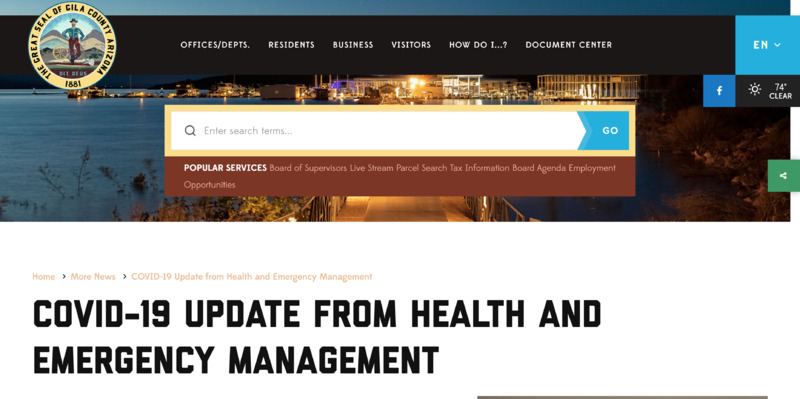
2021-04-06
The Gila County webpage provides clear and concise information for residents on COVID-19 updates, as well as specific data to allow residents who wish to be vaccinated to choose which manufacturer's product they receive. This is unlike any of the major Arizona county sites, or even the state's site, as they do not allow residents to differentiate between the vaccines. Additionally, the information displayed here demonstrates how far ahead rural Gila County is in achieving President Joseph R. Biden's directive to allow all adults in America access to vaccines by April 19.
-
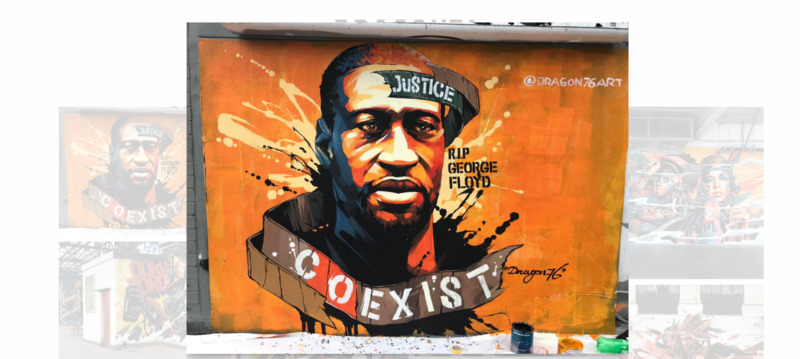
2020
Dragon76, originally from Japan is a world renowned street artist who's art touches on coexistence and justice. This public mural of George Floyd asks those who view it to coexist.
-
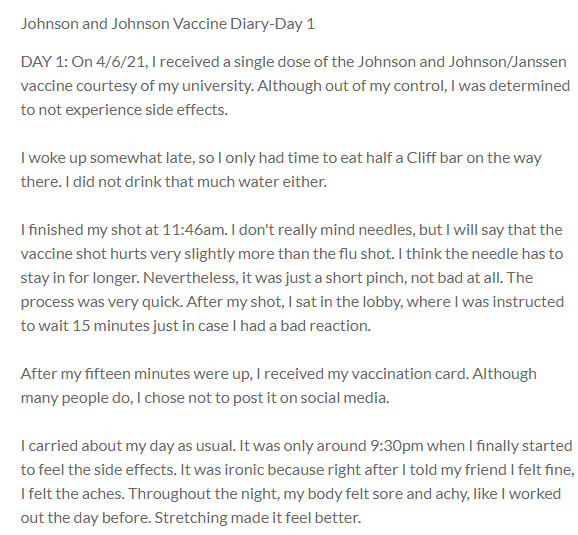
2020-04-06
DAY 1: On 4/6/21, I received a single dose of the Johnson and Johnson/Janssen vaccine courtesy of my university. Although out of my control, I was determined to not experience side effects.
I woke up somewhat late, so I only had time to eat half a Cliff bar on the way there. I did not drink that much water either.
I finished my shot at 11:46am. I don't really mind needles, but I will say that the vaccine shot hurts very slightly more than the flu shot. I think the needle has to stay in for longer. Nevertheless, it was just a short pinch, not bad at all. The process was very quick. After my shot, I sat in the lobby, where I was instructed to wait 15 minutes just in case I had a bad reaction.
After my fifteen minutes were up, I received my vaccination card. Although many people do, I chose not to post it on social media.
I carried about my day as usual. It was only around 9:30pm when I finally started to feel the side effects. It was ironic because right after I told my friend I felt fine, I felt the aches. Throughout the night, my body felt sore and achy, like I worked out the day before. Stretching made it feel better.
At 11:30pm, I was getting fever symptoms. I was extremely tired and had chills, despite being told that my skin felt very hot. I kept shivering despite being wrapped up in a blanket. While I was uncomfortable, the side effects were more of a mild inconvenience. If need be, I could've continued to carry on my day. But it was getting late and I had an early exam the next day, so I decided to snuggle up in a blanket and watch videos until I fell asleep.
-
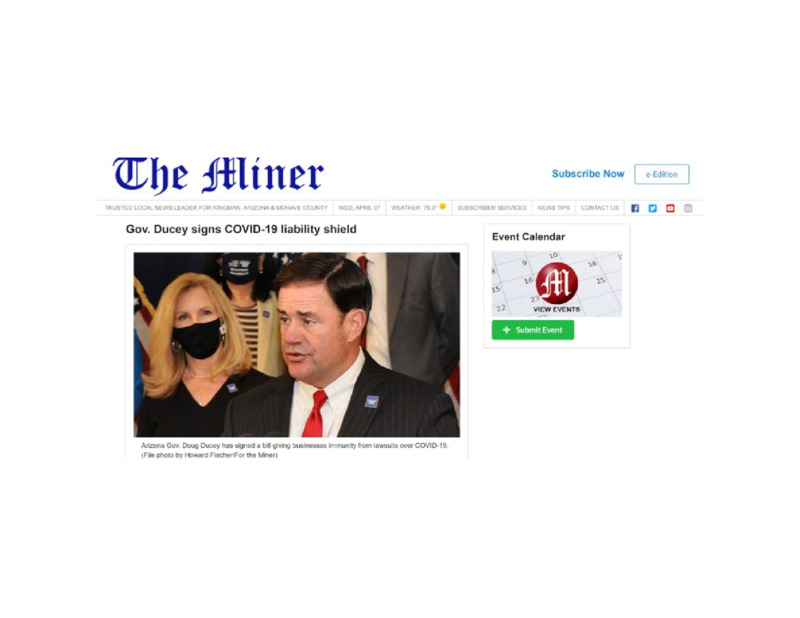
2021-04-06
By Associated Press
Originally Published: April 6, 2021 10:11 a.m.
PHOENIX – Gov. Doug Ducey on Monday signed legislation giving businesses, nursing homes and others a broad shield from lawsuits related to COVID-19, making Arizona the latest state to limit liability after the pandemic.
Republican lawmakers approved the legislation in party-line votes in the House and Senate last week, saying businesses struggled during the pandemic and shouldn’t have to worry about frivolous lawsuits.
The measure was opposed by consumer advocates, who say it will reward bad actors who flouted health guidance and endangered their workers or the public. They say there’s been no deluge of COVID-19 lawsuits.
Business and medical groups have pushed hard for a liability shield since the start of the pandemic. The Arizona bill is one of dozens introduced across the country and in Congress.
Ducey called for the measure in his State of the State address in January. The bill raises the bar for winning a pandemic-related lawsuits against businesses, health care providers, nursing homes, nonprofits, governments, churches and schools. Instead of proving negligence by a preponderance of the evidence, plaintiffs would have to prove “gross negligence” or “willful misconduct” by clear and convincing evidence.
-
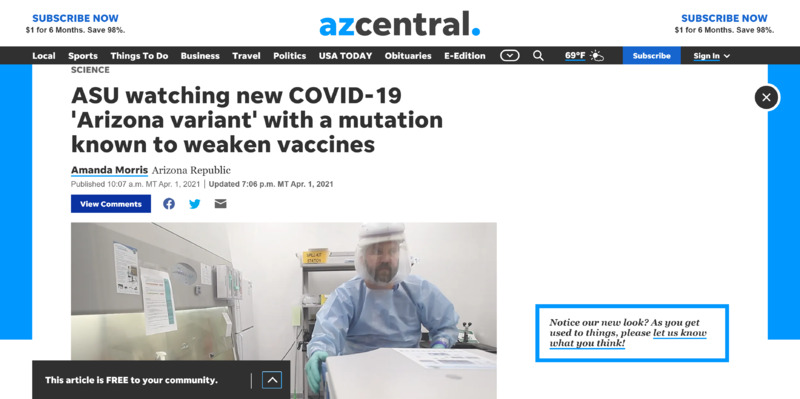
2021-04-01
By Amanda Morris of the Arizona Republic:
Arizona State University researchers have found a home-grown variant of the coronavirus emerging in Arizona that they say should be monitored closely because it carries a mutation known for weakening vaccines.
In a non-peer reviewed study that published Sunday, researchers said they have detected 17 cases of the new variant since February, 15 of which were in Arizona. The other two cases were found in Houston in late February and New Mexico in early March, suggesting that the variant has begun to spread.
"My hope is that we do not see more of these cases. The whole point of surveillance is to keep this from spreading," said Dr. Efrem Lim, an ASU virologist and assistant professor.
The variant is known as the B.1.243.1 variant, and descends from a common lineage of the virus called B.1.243, which nationally makes up about 2.5% of all cases, according to David Engelthaler, director of the Translational Genomics Research Institute's infectious disease division in Flagstaff.
"It's not dominant. But, there's a fair amount of that lineage that has been able to hang around," Engelthaler said. "It seems to have picked up this E484K mutation, what we call the 'eek!'"
This E484K mutation has also been seen in the variants first detected in South Africa and Brazil, as well as one new variant recently discovered in New York.
Numerous studies have shown that this mutation — located in the spike of the virus — lowers antibody responses to the virus and could weaken vaccines. Antibodies are one of the body's tool to recognize and fight the virus.
The E484K mutation has been shown to weaken antibody responses.
One study from Seattle showed that it caused the neutralizing effects of antibodies to decrease by tenfold, and numerous other studies have shown similar results.
American vaccine development company Novavax reported that its COVID-19 vaccine was 96.4% effective against the original coronavirus strain and 86.3% effective against the U.K. variant, but was far less effective in South Africa, where the South Africa variant carrying this mutation is dominant.
In the South Africa trials, the vaccine was shown to be 48.6% effective overall, and 55.4% effective in HIV-negative individuals.
Moderna announced a sixfold reduction in antibody responses from its vaccine against the South Africa variant, and Pfizer observed a drop in vaccine-induced antibody responses against the South Africa variant. The Johnson & Johnson vaccine is reported to be 64% effective against moderate to severe COVID-19 in trials in South Africa vs. 72% effective in U.S. trials.
Though the E484K mutation appears to reduce antibody response and possibly reduce vaccine efficacy, Lim stressed that vaccines still work well and said people should get their vaccines as planned.
Scientists are monitoring mutations in the spike of the novel coronavirus.
Community spread is a concern
Though the new Arizona variant carries this mutation, it's still possible for the variant to fizzle out and stop spreading. Lim said researchers have found two other cases where viruses within the B.1.243 lineage independently picked up the E484K mutation, but did not spread.
"In both cases, they never led to more transmissions," Lim said.
Engelthaler has also tracked other lineages where the E484K mutation showed up, but those strains fizzled out. Overall, researchers have detected over 60 samples containing the E484K mutation statewide, according to TGen's Arizona COVID-19 sequencing dashboard.
In order to continue spread, Engelthaler said variants need to be very "fit."
"This mutation has popped up on multiple instances and then just goes away," he said. "This one mutation by itself doesn't give the virus superpowers."
"It’s definitely a mutation of concern but time will tell if it will be a variant of concern," he added.
If the mutation shows up in a more fit version of the virus, then Engelthaler said it becomes more of a concern.
The new variant in Arizona is different than past cases because it has already spread from one person to another and could spread further, according to Lim. He said "one-off" mutations here and there are normal, but that the bigger question is about the transmission levels of this variant.
A variant's ability to spread to others is also dependent on human behavior, Lim said. If people follow public health guidelines, they are less likely to spread variants to others.
In total, Lim said the new Arizona variant has 11 mutations, which is "quite a bit more" than normal virus variations. These 11 mutations could be helping the virus survive or spread and could also act as a "fingerprint" to help researchers identify the new variant, Lim said.
Another one of the 11 mutations is located in the spike that the virus uses to attach to and infect cells. Engelthaler said that because of the importance of the spike, any mutations in that area could affect things like how fast the virus spreads or how severe the related illness is.
Both Lim and Engelthaler said it's too soon to tell whether the other mutations in this variant have any effect.
Overall, this variant still seems to account for a very low percentage of overall cases in the state, according to Dr. Joshua LaBaer, the executive director of ASU's Biodesign Institute. ASU researchers wrote that it's still possible there are more undetected cases of the variant since there are limited efforts to genetically monitor the virus nationwide.
In Arizona, roughly 1.3% of cases overall have been genetically sequenced, or analyzed, according to TGen's Arizona COVID-19 sequencing dashboard. In February and March, over 3% of cases were sequenced, higher than national rates of sequencing, which were below 1% in January.
ASU is working with the Arizona Department of Health Services to monitor the new variant and hopefully prevent further spread through contact tracing and other public health measures, Lim said.
California and UK variant cases rise
Currently the Arizona variant is only considered a "variant of interest" and not a "variant of concern." These are different categories outlined by the CDC and used to assess the risk level of each variant. The CDC defines "variants of interest" as those that are associated with potential changes, whereas "variants of concern" have evidence showing actual changes such as increased transmission, more severe disease or antibody evasion.
There are five variants of concern, which include variants first identified in the United Kingdom, South Africa, Brazil and California. Two variants from California were elevated from variant of interest to variant of concern this month and have rapidly spread in Arizona.
"They're closely related to each other and have definitely been documented with increased transmissibility and some impact on some antibody treatment," Engelthaler said.
In November 2020, both the California variants accounted for only 0.73% of Arizona's genetically sequenced samples. By March, they accounted for 31.64% of samples and are predominant variants statewide.
One non-peer reviewed study from the University of California San Francisco showed weaker antibody responses against the California variants.
Because of concerns that monoclonal antibody treatments may be less effective against these two variants, the U.S. Department of Health and Human Services announced two weeks ago that it would limit the distribution of one treatment to states with high levels of the California variant, including Arizona.
The California Department of Public Health also recommended that the state stop distributing the treatment, which is made by American pharmaceutical company Eli & Lily. In a health alert, the department said this treatment was unlikely to be active against the California variants.
The U.K. variant, which is highly contagious, has also been spreading statewide ever since it was first detected in late January. In March the U.K. variant accounted for 4.72% of genetically analyzed samples.
Currently, Engelthaler said Arizona has over 100 cases of the U.K. variant and over 1,000 cases of the California variants.
Arizona also detected its first cases of the South Africa variant last week.
So far, Lim said that all of the variants of concern are manageable and have not risen to the level of "variant of high consequence," which the CDC defines as variants that are shown to significantly reduce the effectiveness of prevention and medical measures.
"The risk is whether one of these current variants of concern acquire additional mutations that push it up to the next level," Lim said.
To prevent further mutations, LaBaer said it's important to prevent spread of the virus by continuing to follow health guidelines and getting vaccinated. The more the community can prevent the spread of the virus, the less mutations will occur, he said.
"We're kind of in this race right now between the developed dominance of these much more infectious variants that are now spreading throughout the country and getting people vaccinated," LaBaer said. "At the moment, I'm a little worried that the spread of this virus is so fast that that may outpace our ability to get vaccines in arms."
He said it was theoretically possible that new variants could escape the vaccines, meaning that the public would move backward away from reaching herd immunity.
But Lim said the vaccines can easily be updated to protect against new variants. Pharmaceutical companies like Pfizer and Moderna are already working on developing updated booster shots.
In the meantime, researchers will continue to monitor the Arizona variant to see if it spreads further. Engelthaler said he expects the most fit variants of the virus to become more dominant statewide as people continue to get vaccinated and stamp out less successful strains.
"There's a bit of a race here with the virus — a survival of the fittest race," Engelthaler said. "But what we don't want is to raise too much concern that things are going in the wrong direction...what we're doing is closely watching the evolution of a virus like we never have before. It's good that we have this capability, it's more important to put it into context."
Amanda Morris covers all things bioscience, which includes health care, technology, new research and the environment. Send her tips, story ideas, or dog memes at amorris@gannett.com and follow her on Twitter @amandamomorris for the latest bioscience updates.
Independent coverage of bioscience in Arizona is supported by a grant from the Flinn Foundation.
-
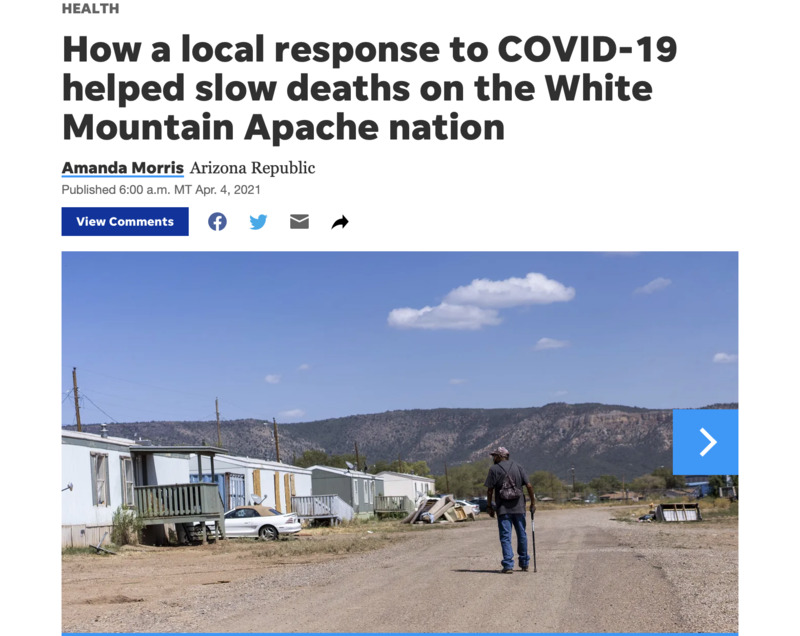
2021-04-04
By Amanda Morris of the Arizona Republic:
When someone on the Fort Apache Indian Reservation receives a confirmed diagnosis of COVID-19, health care workers from the Whiteriver Indian Hospital jump into action.
They personally visit the individual's home to test other household members, perform health evaluations on everyone there and trace any other potential contacts at risk for COVID-19 exposure.
Health care workers in the community say that could be one reason why, even though the rate of confirmed COVID-19 cases among White Mountain Apache tribal members is nearly triple the state's rate, the death rate is much lower and continues to fall.
Over 90% of COVID-19 cases in the White Mountain community are investigated within 24 hours of testing, according to Ryan Close, the director of the Department of Preventative Medicine at the Whiteriver hospital, which is the only hospital on the 1.67 million-acre reservation.
"I feel like what we did made a huge difference," Close said. "We evaluated and admitted people aggressively and early. The tribe deserves an incredible amount of credit for mobilizing staff ... to make this response possible, because at some point it would have been very difficult to maintain without their considerable help."
The quick response may have also helped the tribe turn the tide against rapid community spread of the virus, which scientists say could have been fueled by a single variant found only in the White Mountain tribal communities. The variant carried a mutation in the spike protein, which scientist theorize could have made it spread more rapidly than other strains of the virus.
The number of confirmed COVID-19 cases among White Mountain Apache tribal members accounts for 24% to 28% of their population, according to Close, but the cumulative death rate among known cases is only 1.2%.
By comparison, the statewide rate of infection was 11.5% with a 2% death rate among known cases.
And over the winter, Close said the rate for the tribe dropped even lower, to about 0.5%.
In a community with a high number of individuals with underlying health conditions, the low death rate and work of the tribe has been "remarkable," said David Engelthaler, director of the Translational Genomics Research Institute's infectious disease division in Flagstaff.
The death rate also stands out as unusually low when compared with death rates in other Indigenous communities.
Indigenous populations have been disproportionally affected by the pandemic. CDC data shows that Indigenous people are 3.5 more likely to be diagnosed with COVID-19 and almost twice as likely to die from COVID-19 than white people.
Close credits a proactive strategy to combat COVID-19 that involved rapid contact tracing, in-person health evaluations and frequent outreach to high-risk COVID-19-positive individuals as well as early treatment with monoclonal antibodies and other antiviral therapies.
Volunteers and health workers from the White Mountain Apache community were on the Whiteriver hospital's contact tracing team and high-risk COVID-19 outreach team, which Close said helped the team connect better with the people and work faster.
One essential part of the team are the tribe's community health representatives, or CHRs, who are members of the community that serve as a cultural bridge between patients and medical establishments.
JT Nashio, director of the Community Health Representatives for the tribe, said the "visceral connection" that CHRs have to the community helps them bring cultural awareness to the way questions are asked for contact tracing, which makes the process more effective and allows officials to better distribute information.
"On top of that, quite simply, they know how to get around. It’s a big reservation and not all homes are easy to find," Nashio said. "But when you’ve lived here your whole life, you know where to find people. That became invaluable during the tracing and testing push during case surges."
Virus mutation may have made it more transmissible
When COVID-19 hit the White Mountain Apache nation, it spread rapidly. The community's first documented case was on April 1, 2020, from someone who had likely recently visited the Phoenix area, unknowingly caught COVID-19 and returned, according to Engelthaler.
Within the first few weeks, Close said the community experienced a handful of deaths.
"We soon had incidence rates that were skyrocketing. Case counts were going up very, very quickly," Close said.
It's unclear why the disease spread so rapidly in the community, but the initial strain of COVID-19 that hit the community carried a mutation that Engelthaler believes could have made it more transmissible.
"They were seeing the virus just rip through and have an 80 to 90 to 100 percent attack rate," he said.
TGen partnered with the tribe and the U.S. Indian Health Services early on to provide tests to diagnose a case of COVID-19 and provide genetic analysis of the virus from each case. It showed one strain of the virus circulating in the tribal community that wasn't present anywhere else in the state.
"This virus moved much faster than anything else we were seeing in Arizona at the time," Engelthaler said. "So we actually believe that we had one of these variant strains in Arizona that was causing very large numbers of cases, but it was secluded and maintained really only in that tribal population."
The mutation, called the H245Y mutation, occurred in the spike of the virus, which Englethaler said is a "very sensitive" part of the virus where mutations can have a significant impact.
Because of the low death rate, Engelthaler said TGen researchers would like to investigate the mutated strain of coronavirus seen among tribal members to see if it is also associated with a lower fatality rate.
He acknowledged that other strains of the virus have since entered the community and that the actions of health care workers in the community and at the Whiteriver hospital is also responsible for the lower death rates.
'The earlier you treat an illness, the better'
Close's biggest concern was that an outbreak would cause a "tsunami" of sick COVID-19 patients that would run the risk of overwhelming the Whiteriver hospital, which does not have an intensive care unit. Any patients that require intensive care need to be transported to other hospitals in the state.
"We're a small hospital, we cannot take a wave of all very acute patients because there aren't enough ventilators in the hospital," Close said. "There aren't enough helicopters in the state to transport people out from our facility to a higher level of care."
Within the first few weeks, Close said the community experienced a handful of deaths, and patients who had the poorest outcomes were the ones who self-presented at the hospital — often meaning they waited until they felt sick enough to go to the hospital.
"People don't always bring themselves in early enough," Close said. "The earlier you treat an illness, the better."
In response to this phenomenon, the hospital started a high-risk outreach program the third week of April. Health care workers regularly visited the homes of anyone who tested positive for COVID-19 and was at high risk for a poor outcome.
Close recalls multiple days when he evaluated patients and found their oxygen levels dangerously low, even though they felt fine. It's a condition associated with COVID-19 known as "silent hypoxia," or "happy hypoxia."
"They had no sense that they were even ill. They went on to get pretty sick in the hospital, but they survived and you can't help but think to yourself, 'Yeah, that's a life saved,'" Close said. "That person, if they had stayed home another day or another two days would not have done as well. They would have ended up on a ventilator or something."
The Arizona Republic previously reported that the effects of the high-risk outreach program and contact tracing led to a fatality rate among tribal members of 1.6% last June, which was less than the state's rate of 2.5% and country's at 2.7% at the time.
But the effect of the outreach program became even more pronounced over the winter, as the tribe and health workers gained access to monoclonal antibody treatments, according to Close.
He said the high-risk outreach team started referring patients for antibody treatment in December as part of their protocol after the therapy received emergency use approval from the Food and Drug Administration. Hospital staff at the Whiteriver hospital then administered the antibody treatment.
"We give that to people who are asymptomatic or mildly ill to prevent hospitalization," Close said. "The evidence currently suggests that reduces the risk that they're going to get sicker and get hospitalized and reduces the risk that they're going to die."
Though there's no data proving the antibody treatments made a difference, Close said that after health care workers started using them, the community's COVID-19 death rate fell to 0.5%. Hospital workers also gave antiviral therapies, such as remdesivir, to patients early and often.
"We probably overtreated some people," he said. "But the good news is it definitely led to significant reductions in mortality."
Lessons for the future
Close believes the different programs were so successful because health care workers were often able to test, trace, diagnose and treat individuals all in the same day — a feat he said was only possible because of how closely integrated hospital workers and community health workers were.
"There were no barriers in communication between the public health arm of our response and the clinical care arm of our response," Close said. "It's really a case for an integrated health care system."
As the tribe emerges from the pandemic and tribal members get vaccinated against the virus, Close said the hospital may start exploring other health conditions where it can use the high-risk outreach team, which is already trained and experienced in clinical evaluations.
"The goal is to take what we've learned from COVID and now apply it to things that are not COVID-related," Close said.
Another valuable lesson Close hopes to carry forward is how much of a difference visiting residents in their homes can make and how important building trusting relationships with the community is.
Nashio said going door to door to trace and monitor COVID-19 cases was a natural step for CHRs, who had already gone door to door in the past for other community health campaigns.
"We know firsthand how difficult it can be to not only connect with patients over the phone but communicate effectively over the phone," Nashio said. "When the community sees their CHRs coming to their door, it helps decrease the stigma of the disease."
In addition to performing checkup evaluations and providing information, Nashio said CHRs can also provide food, medical supplies, cleaning supplies or services like grocery shopping and running basic errands.
Not every tribal member has reliable internet or phone service, nor access to transportation, so Close said going door to door can be a good way to reach, and help, everyone.
"Meeting patients where they are is invaluable," Close said.
Amanda Morris covers all things bioscience, which includes health care, technology, new research and the environment. Send her tips, story ideas, or dog memes at amorris@gannett.com and follow her on Twitter @amandamomorris for the latest bioscience updates.
Independent coverage of bioscience in Arizona is supported by a grant from the Flinn Foundation.
-
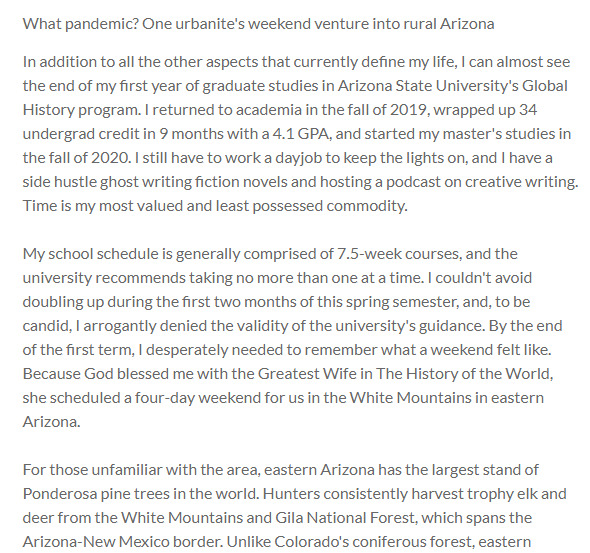
2021-03-04
In addition to all the other aspects that currently define my life, I can almost see the end of my first year of graduate studies in Arizona State University's Global History program. I returned to academia in the fall of 2019, wrapped up 34 undergrad credit in 9 months with a 4.1 GPA, and started my master's studies in the fall of 2020. I still have to work a dayjob to keep the lights on, and I have a side hustle ghost writing fiction novels and hosting a podcast on creative writing. Time is my most valued and least possessed commodity.
My school schedule is generally comprised of 7.5-week courses, and the university recommends taking no more than one at a time. I couldn't avoid doubling up during the first two months of this spring semester, and, to be candid, I arrogantly denied the validity of the university's guidance. By the end of the first term, I desperately needed to remember what a weekend felt like. Because God blessed me with the Greatest Wife in The History of the World, she scheduled a four-day weekend for us in the White Mountains in eastern Arizona.
For those unfamiliar with the area, eastern Arizona has the largest stand of Ponderosa pine trees in the world. Hunters consistently harvest trophy elk and deer from the White Mountains and Gila National Forest, which spans the Arizona-New Mexico border. Unlike Colorado's coniferous forest, eastern Arizona seems devoid of pine beetle kill. Nothing but healthy, evergreen forest and the scent of sun-warmed pine greets you.
We stayed in a vacation home on the outskirts of Pinetop, brought our groceries from home, and largely intended on hiking, cooking, drinking, and doing a lot of nothing. When we arrived in Pinetop in early March 2021, I had already fully recovered from COVID-19 and had time for both of my Moderna vaccines to have taken full effect. My wife had neither protective barrier, but we had generally become comfortable with purpose-driven shopping (as opposed to "window shopping") and takeout dining. As such, we stopped into a bakery to get breakfast on the way out to the hiking trails as a vacation treat. To our surprise, many of the patrons weren't wearing masks while walking through the restaurant or waiting in line. That made us a little uncomfortable. Then, one of the employees walked out from the kitchen with no mask on and began working on filling orders at the front, cold-food storage counters. Both of us panicked a bit and considered cancelling our orders and leaving.
My wife pulled up the Arizona Department of Health Services site and quickly found that entire county had endured only a little more than 560 cases. A quick bit of division translated that into an average of two infections per day for the entire pandemic year-to-date. The statistical odds of the unmasked clerk or patrons presenting a health risk to either of us fell to just north of zero. NOT zero, but we both felt we could see it from there. The ham, egg, and cheese croissants were delicious, by the way.
In trying to be good guests, we continued to wear our masks whenever we ventured into public spaces and businesses. Less than half of those around did the same, and I didn't see or hear anyone confront each other about mask wearing.
Our last venture out that weekend was to a beer garden with a prominent outdoor patio and seating area. We again wore our masks inside the establishment, but we immediately felt like outcasts for having done so. When we stepped inside, it looked as though the town villain had just stepped through the saloon doors: all activity inside the business stopped, and everyone seated inside turned around to look us up-and-down for few silent moments. If anyone had been playing piano, they would have switched to a minor key. NO ONE else inside wore a mask, and the interior tables didn't appear to have been spaced to comply with prevailing social distancing guidelines. Everyone stayed kind of quiet until we ordered beers and asked to sit outside. In hindsight, I wonder if they expected we were there from some government bureaucracy to issue citations, or just out-of-towners about to have a value-based hissy fit?
I have been generally opposed to broad behavior mandates that typically justify compliance on urban problems, but that weekend compelled me to really consider the divergent pandemic realities Arizonans have endured for the past year. Further analysis of county-specific data seems to suggest at least four divergent pandemic experiences within Arizona: urban centers, border counties, rural counties, and Native American reservations. I hope to better understand the personal experiences of those who lived in these diverse regions and how the pandemic affected their perspective and reality.
-

2020-12-31
This article captures images of several murals around the world that were tributes to George Floyd, Breonna Taylor, Trayvon Martin, and Ahmaud Arbery, Kobe Bryant, and Chadwick Boseman, to doctors and nurses, "as well as messages of hope, strength, and resilience in the face of the global health crisis and ensuing economic downturn."
-

2020-06-08
Interview with London street artist Ben Eine and his experiences during the pandemic.
-

2020-05-19
Houston-based artist Anat Ronen brings hope to her community through her public art during the pandemic.
-

2021-03-17
Japanese, New York-based street artist DRAGON76 has just completed a mural in East Village, Manhattan, supporting the “STOP ASIAN HATE” movement. The “STOP ASIAN HATE” mural can be found at East Village, 75 Chrystie St, Lower East Side, Manhattan.
-
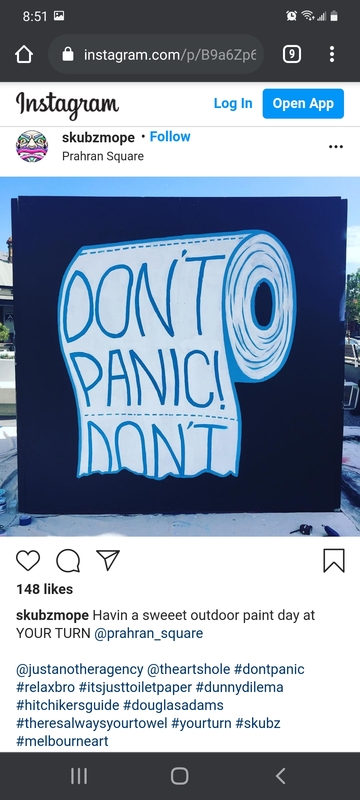
2020-03-06
Graffiti of a toilet paper roll and the text, "DON'T PANIC"... People were panic buying items like toilet paper when the pandemic really started to take off in infection and death rates and quarantine/lockdowns were initiated in the spring of 2020.
-
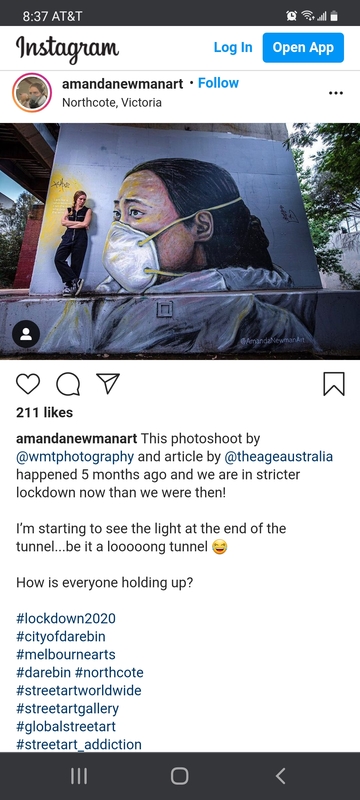
2020-05
Artist Amanda Newman created a mural of senior Doctor Ai Fen if the Wuhan Central Hospital. The image is on a pillar of a railway overpass in Urquhart Street, Northcote. Newman chose the doctor as her subject because she was silenced, reprimanded, and accused of spreading rumors during the beginning stages of the COVID-19 outbreak in December 2019.
-
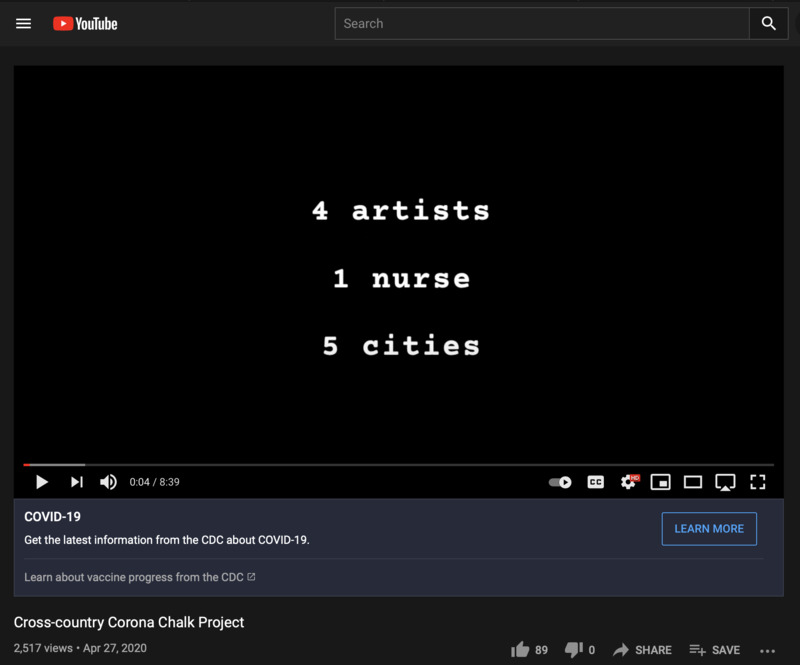
2020-04-27
A group of chalk artists connected remotely to create a piece of chalk art to honor frontline workers. The artists were Naomi Haverland from Seattle, Washington, Jolene Russell from Sacramento, California, Anat Ronen from Houston, Texas, Jessi Queen from Atlanta, Georgia, Shelly and Dave Brenner from Ann Arbor, Michigan. Dave photographed his wife Shelly, who is also a Certified Registered Nurse Anesthetist, for a collaborative chalk art piece with each artist making their part in their hometown.
-
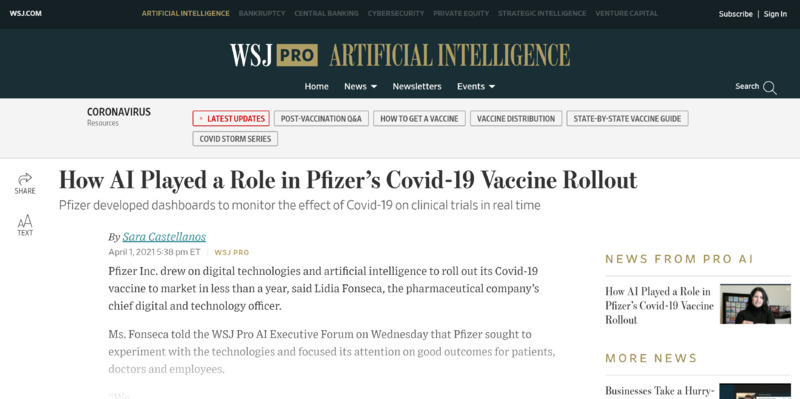
2021-04-01
This Wall Street Journal PRO article on Pfizer's use of artificial intelligence discusses that company's use of predictive technologies to identify geographic areas with the greatest potential for its COVID-19 vaccine clinical trials.
-

2021-04-06
This sub-article was the lead item in this week's Wall Street Journal PRO "Artificial Intelligence Weekly" email blast:
"By Angus Loten
Welcome back. Artificial intelligence is set to take a decisive role in shaping the post-pandemic economy, from helping employers reopen workplaces to getting supply chains back on track. Corporate technology leaders and industry analysts offered these and other insights at last week’s virtual edition of the WSJ Pro AI Executive Forum. Some of their views are outlined in the sections below. One broad takeaway: Though still in its infancy, AI is already having a profound impact on our daily lives.
Pfizer’s Speedy Vaccine Rollout
Pfizer Inc. last year developed AI-powered dashboards designed to monitor the effect of Covid-19 on clinical trials in real time, ultimately helping the pharmaceutical giant roll out its coronavirus vaccination in less than a year, The Wall Street Journal’s Sara Castellanos reports.
A shot in the arm. Pfizer fed large amounts of case-rate data into AI-enabled predictive models to quickly generate site selection for clinical trials, said Lidia Fonseca, the company’s chief digital and technology officer.
A smart move. Pfizer two years ago began experimenting with the emerging technologies, focusing on digital tools that promised to offer better outcomes for patients, doctors and employees, with results it was able to draw on during the pandemic, Ms. Fonseca said."
-
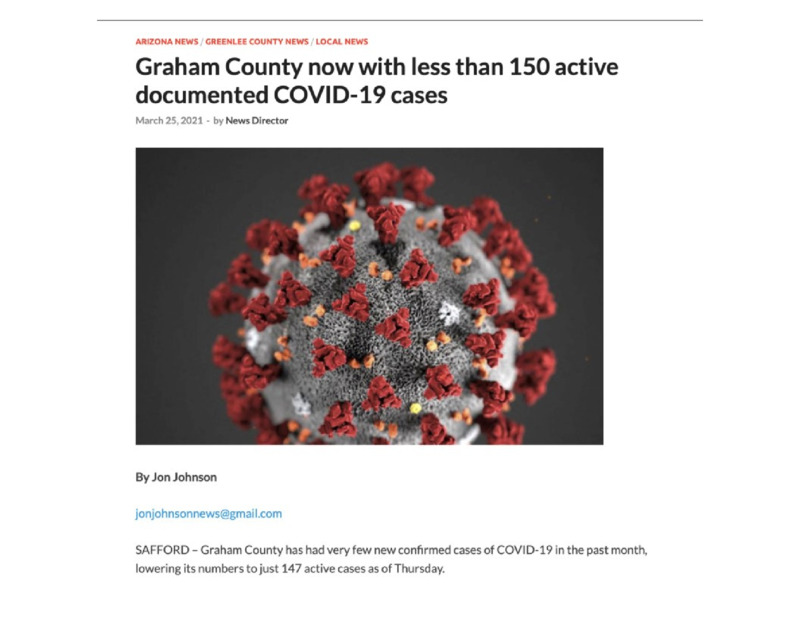
2021-03-25
"By Jon Johnson, jonjohnsonnews@gmail.com
SAFFORD – Graham County has had very few new confirmed cases of COVID-19 in the past month, lowering its numbers to just 147 active cases as of Thursday.
According to the Graham County Department of Health and Human Services, Graham County has had a total of 5,355 confirmed cases for the course of the pandemic, with 5,132 listed as being recovered, 147 active, and 76 deaths in more than a year.
No new cases were recorded Thursday, and, according to the Arizona Department of Health Services COVID-19 school dashboard, Graham County had just a 1 percent positivity rate as of the week of March 14. That is good for a tie with Apache County for the second-lowest percent positivity rate out of Arizona’s 15 counties. Only Greenlee County, which registered a zero percent positivity rate from Feb. 27 – March 14, had lower.
With the lower cases statewide and vaccine rollout, Governor Doug Ducey issued an Executive Order on Thursday, rolling back several COVID-19 mitigation measures involving businesses and gatherings. This comes as other states roll back their COVID-19 mitigation measures as well.
The rollout of the various COVID-19 vaccines has picked up steam in the last month, with the state opening up the vaccine to anyone 16 years old or older for the Pfizer vaccine. Anyone 18 years old or older can be administered the Moderna and Johnson & Johnson vaccines. The San Carlos Apache Healthcare Corporation is holding a free, drive-through vaccine clinic on Saturday, March 27 at the San Carlos High School. No appointment is necessary. The clinic will be administering both the Pfizer and Moderna vaccines.
Graham County and Greenlee County are also providing vaccination sites for those 18 and older, and provide the Moderna and Johnson & Johnson vaccines.
Greenlee County:
According to the Greenlee County Health Department, the county currently has just nine active cases of COVID-19.
For the course of the pandemic, Greenlee County has had 568 confirmed positive cases (by far the lowest out of any of Arizona’s 15 counties), with 549 recovered cases, nine active, and 10 deaths."
-
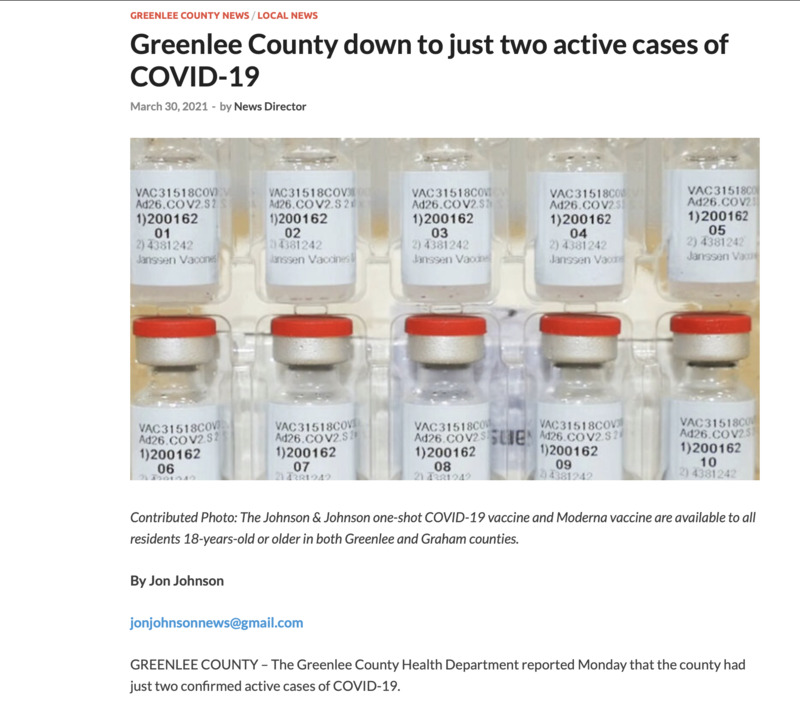
2021-03-30
"By Jon Johnson, jonjohnsonnews@gmail.com
GREENLEE COUNTY – The Greenlee County Health Department reported Monday that the county had just two confirmed active cases of COVID-19.
Greenlee County has tested more than 5,000 people for the course of the pandemic and has had a total of 568 cases, with 556 recovered and 10 deaths.
The county offers the Moderna COVID-19 vaccine to all residents 18-years-old or older, and on Thursday (01-April-2021) Gila Health Resources will have a vaccine clinic for the one-shot Johnson and Johnson COVID-19 vaccine. Click here to learn more or to register.
According to the Arizona Department of Health Services, 37.5 percent of Greenlee County’s residents have been vaccinated for COVID-19. That is the highest percentage out of Arizona’s 15 counties. Conversely, Graham County is listed as having just 18.1 percent of its population vaccinated, which is the third-worst out of Arizona’s counties behind Maricopa County at 17.5 percent and Apache County at 10.7 percent.
Graham County:
The Graham County Department of Health and Human Services reported three new confirmed positive tests for COVID-19 on Tuesday.
While Graham County has had 5,364 total confirmed cases of COVID-19, as of Tuesday the county had just 138 confirmed active cases. Out of all its confirmed cases, 5,150 are listed as being recovered, and 76 have died.
Graham County is also offering both the Moderna and Johnson & Johnson vaccines to all residents 18-years-old or older. Click here for more information."
-
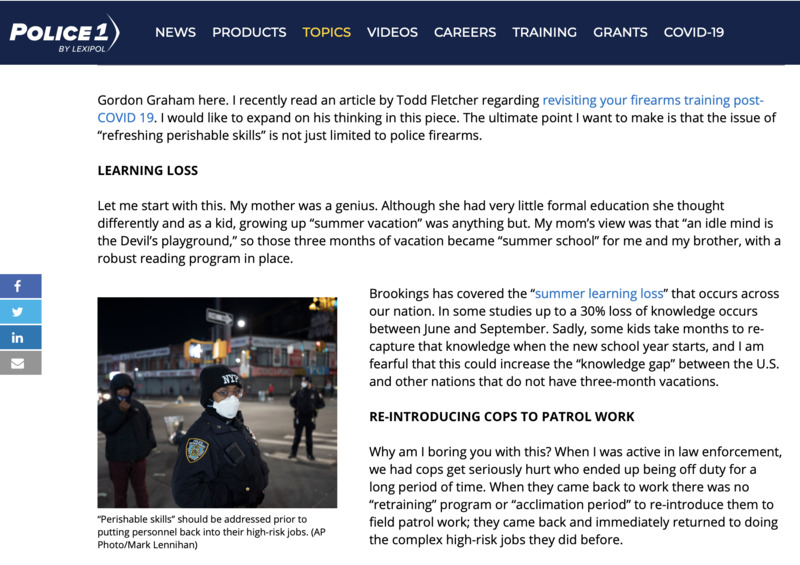
2021-03-10
In this article, retired California Highway Patrol Lieutenant, attorney, and professional risk manager Gordon Graham discusses the factors police agencies should be considering and planning for as we hope to soon begin transitioning to a post-COVID/post-pandemic world. Among these are traditional and analogous considerations agencies have long dealt with, such as the return of employees from extended military assignments or recovery from injuries. Many of the finely honed skills that helped keep officers and the public safe prior to February 2020 will have eroded from a lack of use, and it will be incumbent upon agencies and officers alike to undertake these returns to normalcy with serious and deliberate caution.
-

2021-04-05
This article from Oregon Live/The Oregonian was picked up by Police1, and it discusses a number of exit interviews that retiring and resigning Portland Police Bureau officers, detectives, and administrators left during the past year. Of particular interest is the section that discusses the story of Jaykary Jackson:
"Young officers of color have left, including Jaykary Jackson, who went to Boise, and Elise Temple, who was one of the Police Bureau’s recruiters. Temple declined to comment on the record.
Jackson didn’t respond to messages but he was one of the officers who spoke out last summer about being on the front line of racial justice protests as an officer with the Rapid Response Team.
A graduate of Portland State University who joined the Police Bureau after working for Nike for 10 years, he said then that he became a cop because he “wanted to make the most out of my life by helping others.” He also was following in the footsteps of his father and aunt.
But Jackson said he was disgusted by the hatred he and other officers faced while standing on the police lines. He got hit by an explosive one night, felt tingling in his fingertips and heat from the device, and got berated by young white protesters.
Often when he tried to talk to someone of color at the protests, he said, “Someone white comes up and blocks them and tells them not to talk.” Or yells, “Eff the police ... don’t talk to him.” He left shortly after he was named to be a new community engagement officer."
The article illustrates the additional concerns that officers in major cities and law enforcement agencies face, especially when their civilian oversight overwhelmingly seeks to placate protests with emotional vindication in lieu of reasoned, rational, and planned reforms.
-
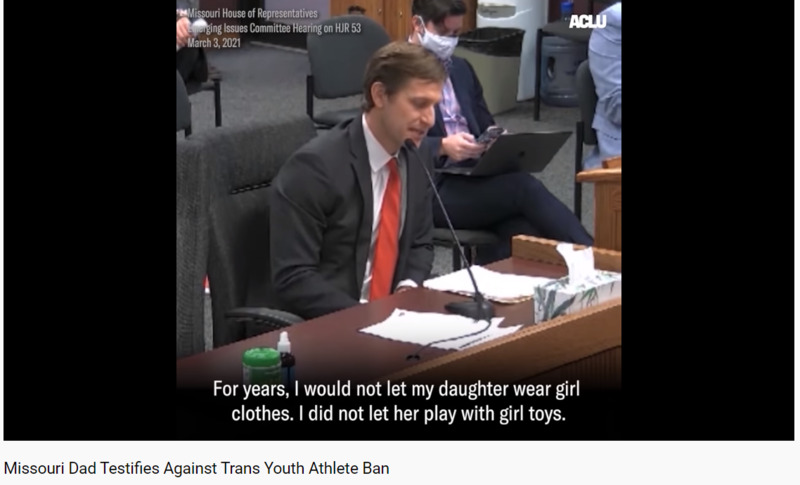
2021-03-15
“As a parent the one thing we cannot do…is silence our child’s spirit.”
Brandon Boulware, father of a transgender daughter, urged Missouri lawmakers to stop discriminating against trans youth while testifying in a hearing about trans youth athlete ban HJR 53.
Parents, coaches, doctors, and student athletes are all coming together to say that trans people belong everywhere. Trans girls are girls, and they shouldn’t be barred from participating in sports.
-
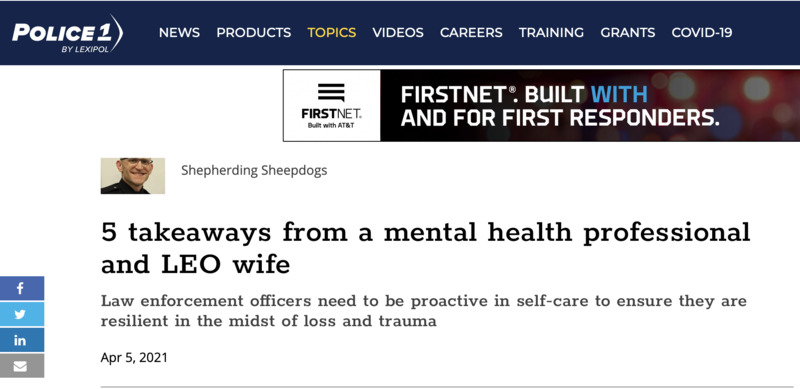
2021-04-05
This article discusses guidance for law enforcement professionals to adopt better self-care practices through this pandemic and the increased volume of vicarious trauma, depression, anxiety, and suffering prevalent in our societies. The author specifically addresses the problem of police suicide, which is often committed at similar rates to military combat veterans. While the article's content helps officers potentially deal with the difficulties of their calling, it might also help the public better recognize the darker and unwelcome realities of police work.
-
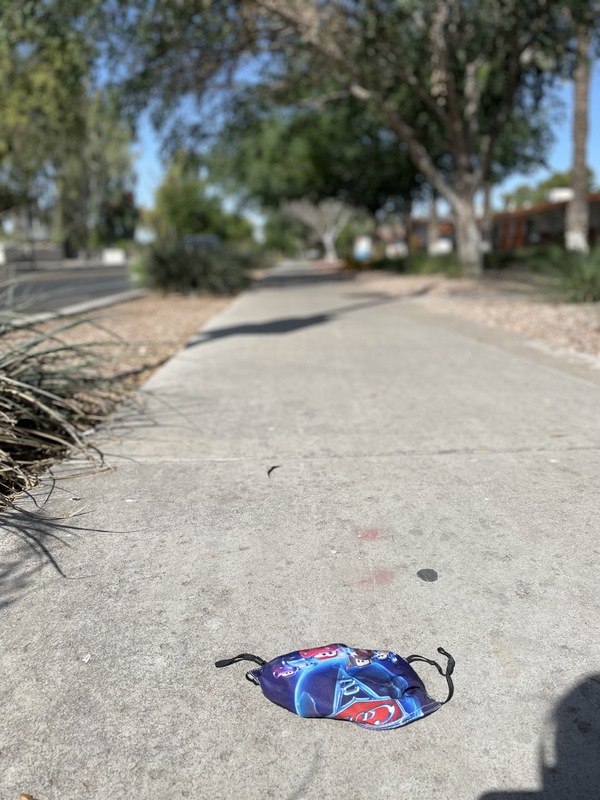
2021-04-06
A child's re-usable face mask with Cars 2 design found on the sidewalk across from Jaycee Park in Tempe, Arizona.
-
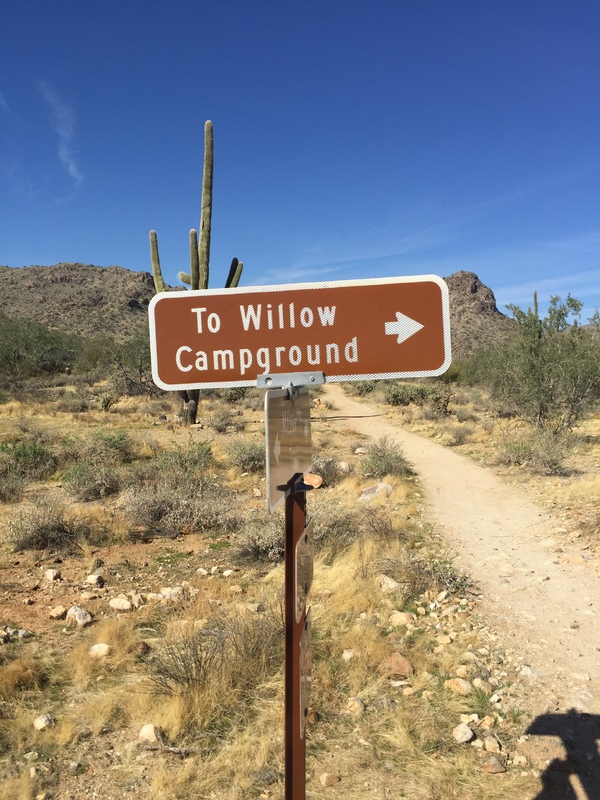
2021-02-06
My husband and I went camping in February 2021 at the White Tanks Regional Park.
-
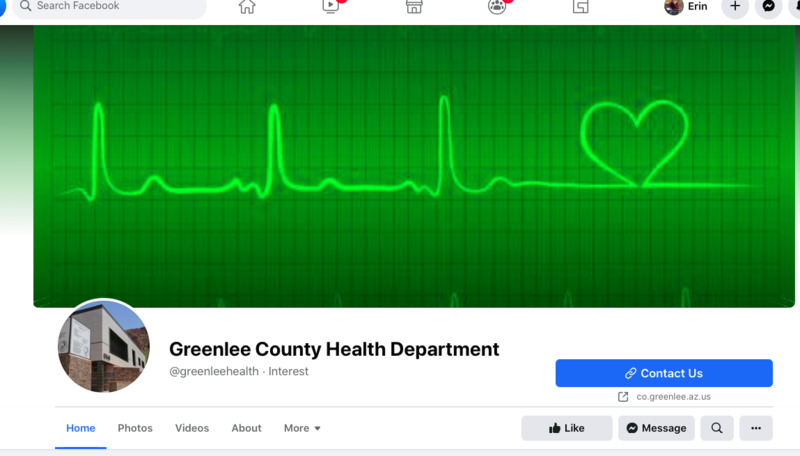
2021-04-05
The Greenlee County Health Department uses its Facebook page to disseminate daily information related to the COVID-19 pandemic to its residents. The daily COVID-19 statistics are displayed as an image on the daily Facebook post, which allows examination of the department's content and messaging before and after the pandemic. Governor Doug Ducey declared a state of emergency in Arizona on March 11, 2020, which seems inconsistent with GCHD's daily posts from that period. Language on the GCHD posts consistently advised residents to stay home if they felt ill, rather than being consistent with Governor Ducey's voluntary Stay Home orders.
For example, the March 30, 2021, press release to update a new active COVID-19 infection in Greenlee County reads as follows:
"For Immediate Release, Tuesday, March 30, 2021, Greenlee County, Arizona.
Public Information Contact: Steve Rutherford (928) 865-2601
NEW RELEASE - COVID-19 Positive Test in Greenlee County
The Greenlee County Health Department is investigating one (1) new confirmed case of COVID-19. The case will put our current total at five hundred and sixty-nine (569) confirmed Greenlee County COVID-19 cases...
We would like to remind the community to use masks appropriately when outside of the home, practice social distancing, wash your hands frequently, and do not go into the public when you are feeling sick, unless you are seeking medical attention."
These updates demonstrate a significant dichotomy between the rural and urban experiences during this pandemic.
-
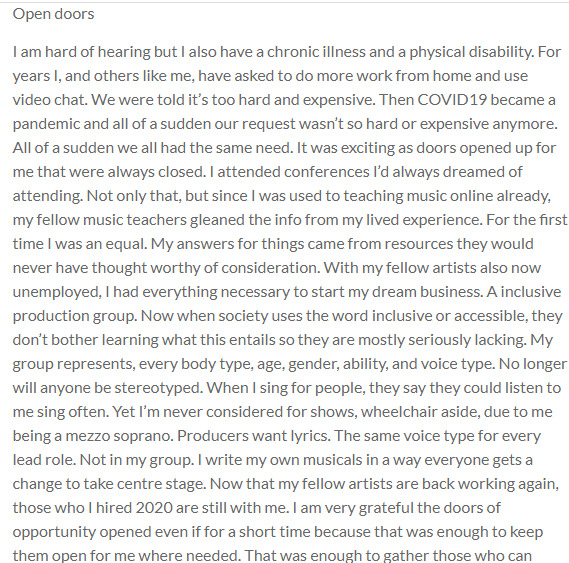
2021-04-06
I am hard of hearing but I also have a chronic illness and a physical disability. For years I, and others like me, have asked to do more work from home and use video chat. We were told it’s too hard and expensive. Then COVID19 became a pandemic and all of a sudden our request wasn’t so hard or expensive anymore. All of a sudden we all had the same need. It was exciting as doors opened up for me that were always closed. I attended conferences I’d always dreamed of attending. Not only that, but since I was used to teaching music online already, my fellow music teachers gleaned the info from my lived experience. For the first time I was an equal. My answers for things came from resources they would never have thought worthy of consideration. With my fellow artists also now unemployed, I had everything necessary to start my dream business. A inclusive production group. Now when society uses the word inclusive or accessible, they don’t bother learning what this entails so they are mostly seriously lacking. My group represents, every body type, age, gender, ability, and voice type. No longer will anyone be stereotyped. When I sing for people, they say they could listen to me sing often. Yet I’m never considered for shows, wheelchair aside, due to me being a mezzo soprano. Producers want lyrics. The same voice type for every lead role. Not in my group. I write my own musicals in a way everyone gets a change to take centre stage. Now that my fellow artists are back working again, those who I hired 2020 are still with me. I am very grateful the doors of opportunity opened even if for a short time because that was enough to keep them open for me where needed. That was enough to gather those who can make and keep this dream a reality. We are set to debut our first show in June 2021. It doesn’t get better than that. So while COVID itself is horrendous, the lifestyle the pandemic made universal helped others see what we live daily, and it also created a more universal work place for all.
-

03/30/2021
Living in military housing with their spouse and two children in California, the narrator chooses to remain anonymous. Throughout the interview, the narrator speaks at length about their COVID-19 pandemic experience. They go on about how they go tackle socialization, especially for their children, as they are not able to travel very far from home. They talk about what precautions they take whenever they leave the house, and how they would not let the pandemic restrictions completely dictate their new norm. Although their children are none the wiser considering their young ages, they continue to create a sense of normalcy that would simulate a pre-pandemic lifestyle. Delving deeper into safety measures, the narrator expresses their thoughts and hopes about how people in their community are taking precautions. This includes how they would hope that everyone is being honest and doing their part in assuring everyone’s mutual safety, such as informing them if they or their children are sick.
-
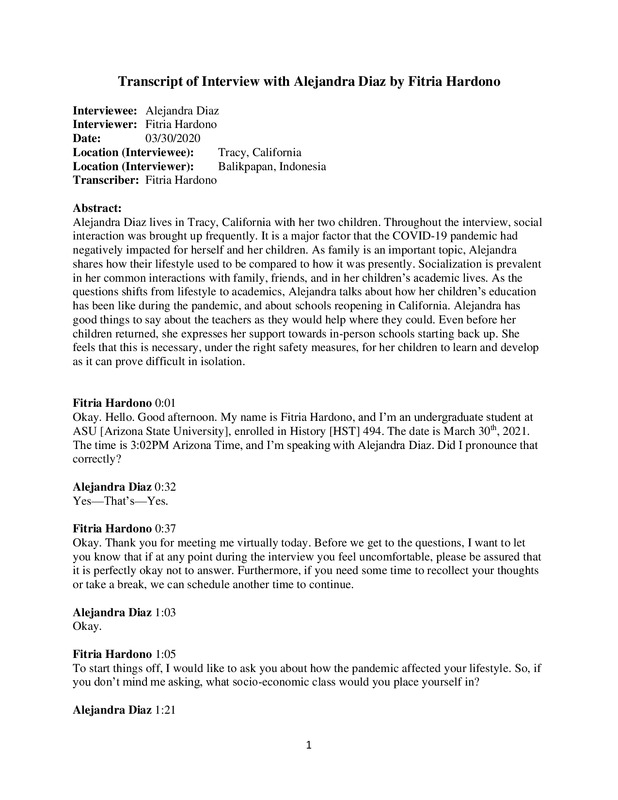
03/30/2021
Alejandra Diaz lives in Tracy, California with her two children. Throughout the interview, social interaction was brought up frequently. It is a major factor that the COVID-19 pandemic had negatively impacted for herself and her children. As family is an important topic, Alejandra shares how their lifestyle used to be compared to how it was presently. Socialization is prevalent in her common interactions with family, friends, and in her children’s academic lives. As the questions shifts from lifestyle to academics, Alejandra talks about how her children’s education has been like during the pandemic, and about schools reopening in California. Alejandra has good things to say about the teachers as they would help where they could. Even before her children returned, she expresses her support towards in-person schools starting back up. She feels that this is necessary, under the right safety measures, for her children to learn and develop as it can prove difficult in isolation.
-
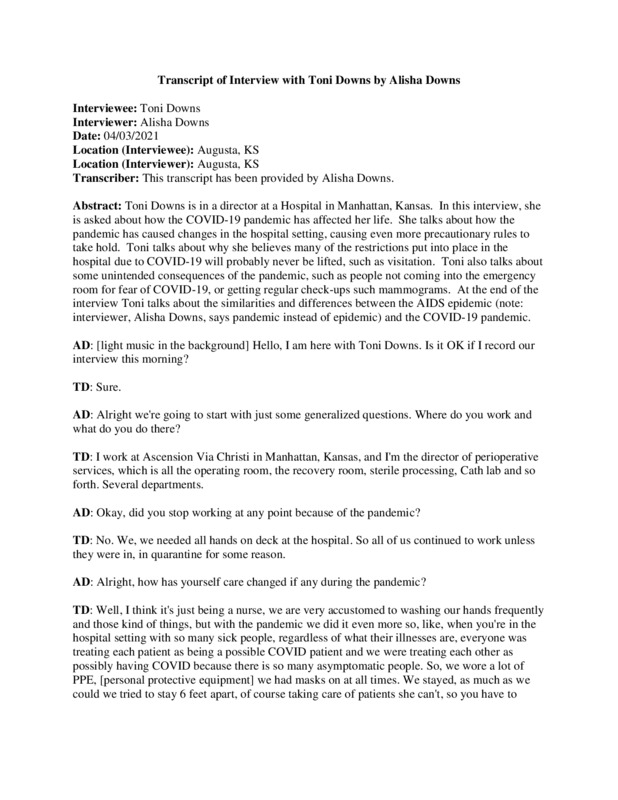
2021-04-03
Toni Downs is in a lead position at a hospital in Kansas. In this interview, Toni tells me about changes that have occurred at the hospital as a result of the COVID-19 pandemic. She also discusses the long term changes she suspects will stay in effect, such as visitation regulations to the hospital. Toni tells me about similarities and differences between this pandemic and the start of the AIDS pandemic. She also discusses how the number of people going to the emergency room have dropped significantly, more than 75% at the start of the pandemic. Toni believes if we all work together at stopping the spread, we will get this under control. However, she thinks many things may stay around for a while in the hospital setting, such as the before mentioned visitation rules, and even mask wearing, in order to protect hospital staff and the patients.
I am researching the unexpected consequences of the COVID-19 pandemic, such as people skipping mammograms for fear of catching COVID at the doctors office. I chose to interview Toni for my research, due to her insider knowledge of the inner workings of a hospital.
-
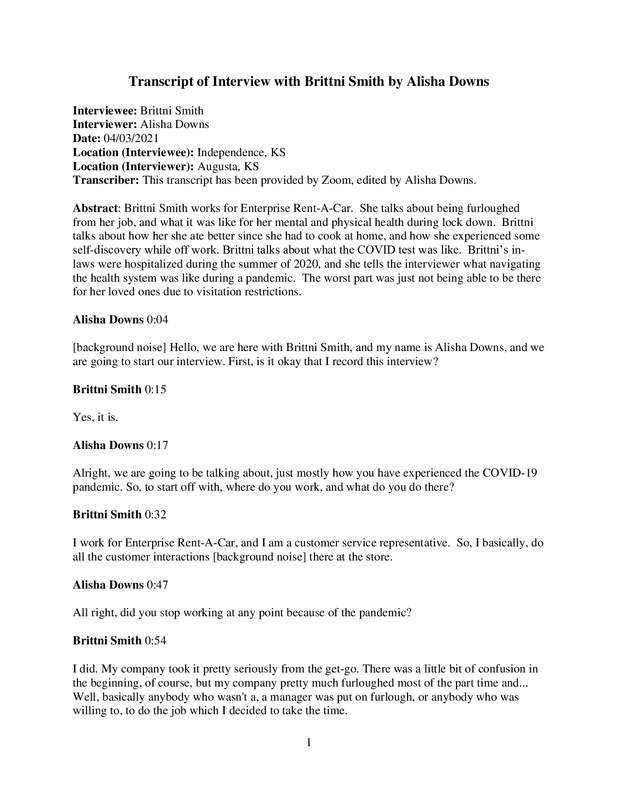
04/03/2021
Brittni Smith lives in a small town in Kansas. Here, I interview her about her experiences during the COVID-19 pandemic. She talks about what it was like getting a COVID test. Brittni also tells me about what it was like to have family hospitalized during a pandemic. Her work furloughed her for a few months at the beginning of the pandemic, which she also tells me about.
I am researching the unexpected consequences of the pandemic; a good example would be people not going to the doctor for checkups for fear of catching COVID. I interviewed Brittni for this research.
-
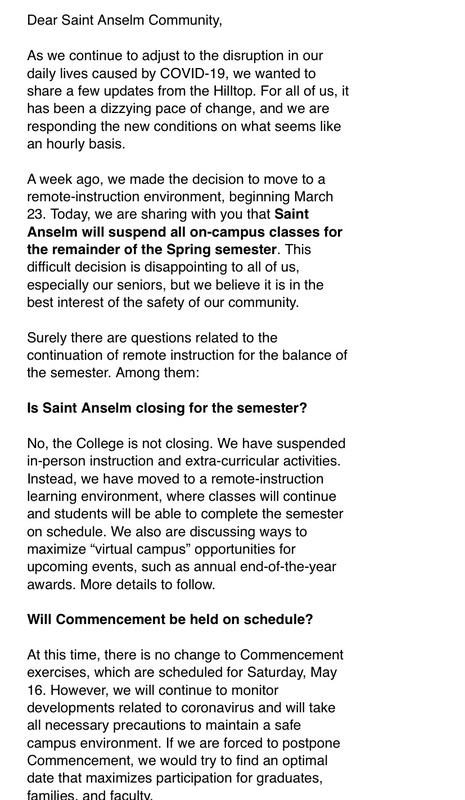
2020-03-20
Around mid-March, all of the students of my college received an email that on-ground instruction had been suspended and that we all had 48 hours to leave campus.
-
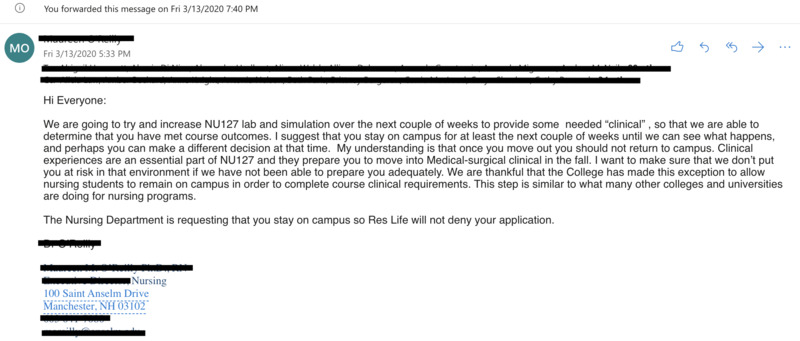
2020-03-13T15:10
These were a sequence of emails I received as my college prepared to shut down on March 13th, 2020. This created an immense amount of stress and chaos for myself, my family, and my friends. We were concerned about being isolated on campus away from our families during such a scary, life changing time. The emails embody the idea that we would be able to remain in person, continuing our education in a normal way. This indicated that we truly did not understand the full complexity and severity of the issue. There was a lot of chaos and uncertainty during the weekend of the 3/13/2020-3/14/2020. Earlier in the week, a trusted professor indicated to us that it was only a 50% chance we would actually be sent home so we were absolutely shocked at the decisions.
-

2021-02-07
Jazmine Sullivan and Eric Church sing the National Anthem for the Super Bowl LV Pregame Show. Warren “Wawa” Snipe performed the song in ASL. The Kansas City Chiefs take on the Tampa Bay Buccaneers during Super Bowl LV in Tampa Bay.
-
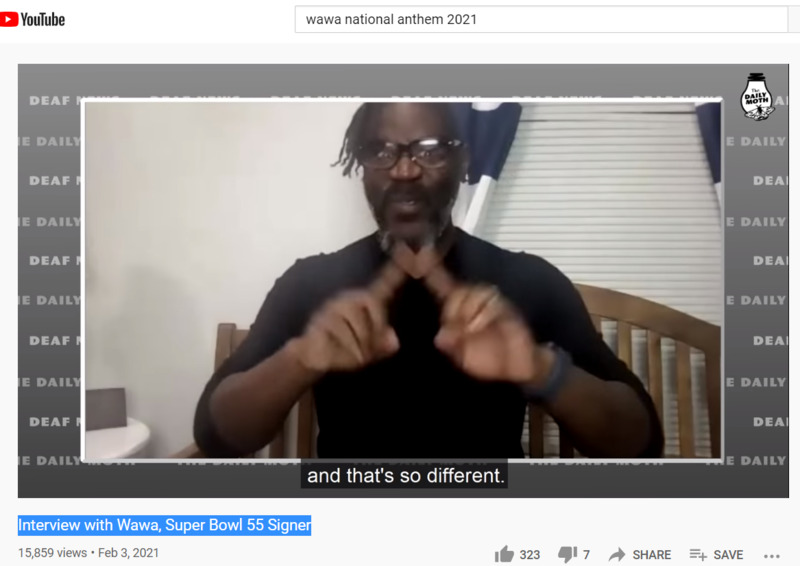
2021-02-03
Interview with Warren "Wawa" Snipe about his gig with Super Bowl 55 this Sunday. We also discuss his new album, “Wamilton,” and his genre of Dip Hop.
-
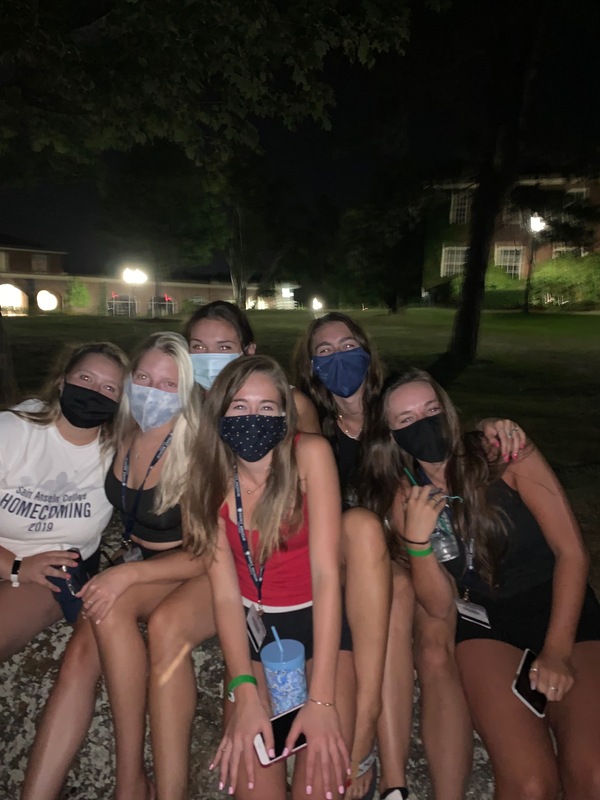
2020-08-27
Friday, March 13th, 2020 I received an email from President Favazza of Saint Anselm College that the whole campus was being shut down and we had until Sunday to move out of our dorm rooms and go home. We stayed in lock down for months- zoom, tiktok, family, boredom, walks, and eating are what my days consisted of. We got an email that we would be returning to campus in August we new protocols- masks, family units, hybrid classes. We did not care about the rules, we were just happy to be back and see new people. We got sent home second semester of our freshman year, what we thought would last a couple of weeks has now infected more than a year of our college experience. Masks, remote learning, social distancing, and COVID testing is our new normal. The photo above shows my friends and I on the Alumni quad at Saint Anselm College. It was a summer Friday night and we were trying to make the most of our time at college. My friends and I often spent a lot of our time outside. We ate lunch on the quad, spent our weekends on the quad, and did our classes outside. We realized that we needed to make the most of being outside because we had been locked inside for 3 months. We adapted to a huge change in what is supposed to be the best years of our lives.
-
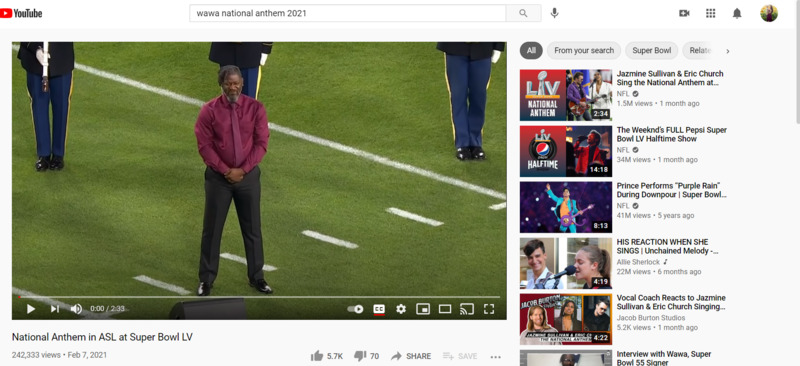
2021-02-07
What a performance! Warren "Wawa" Snipe performed two songs during the Super Bowl. The National Anthem and America the Beautiful. He really stole the show! Kissfist! Muah!
The performers were socially distanced. I wanted to add this to the archive so everyone can see Wawa's performance. He interpreted for artist H.E.R. Do you see the end? He knew he nailed it. Representation and inclusivity matter.
-
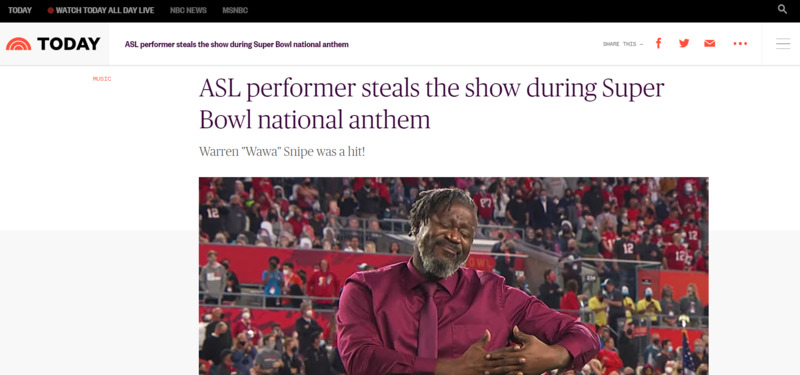
2021-02-07
Warren “Wawa” Snipe, who is deaf, performed the song in American Sign Language, and won over fans in the process. He also performed during H.E.R.'s rendition of "America the Beautiful."
-
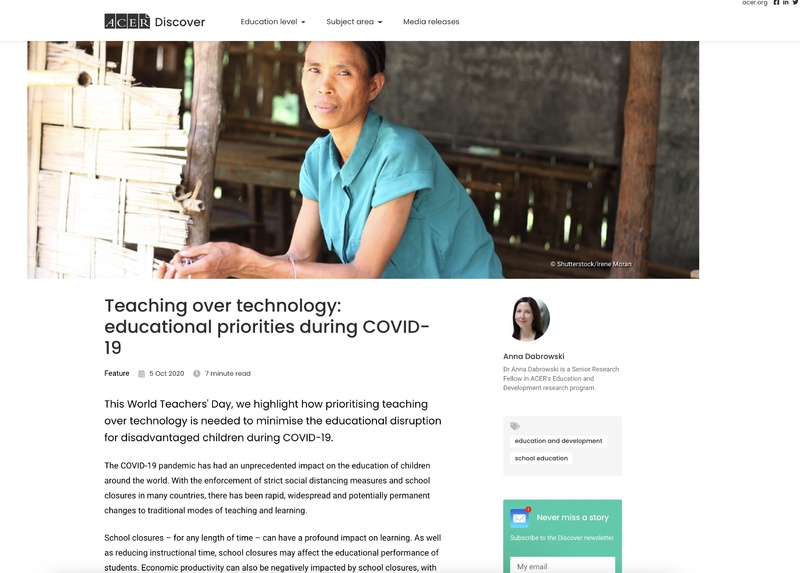
2020-10-05
This article focuses more on the teaching side of the shift to online schooling. The reading mostly discusses different challenges that teachers face in regards to accesses with technology or ways that they can work with disadvantaged students during the pandemic. The second half of the reading focuses mostly on the support and recognition that teachers deserve due to the circumstances provided by COVID-19.
-

2020-06-04
This article discusses mostly how teachers are changing their beliefs/enhancing abilities due to the switch onto the online function. The article discusses a number of relevant topics such as teacher's capabilities to utilize educational technology, ability to troubleshoot technology problems, and technological environments for both students and teachers. There is also discussion on their views on the online teaching format, as well as their responses regarding economic and technological disparities for certain groups of students.
-
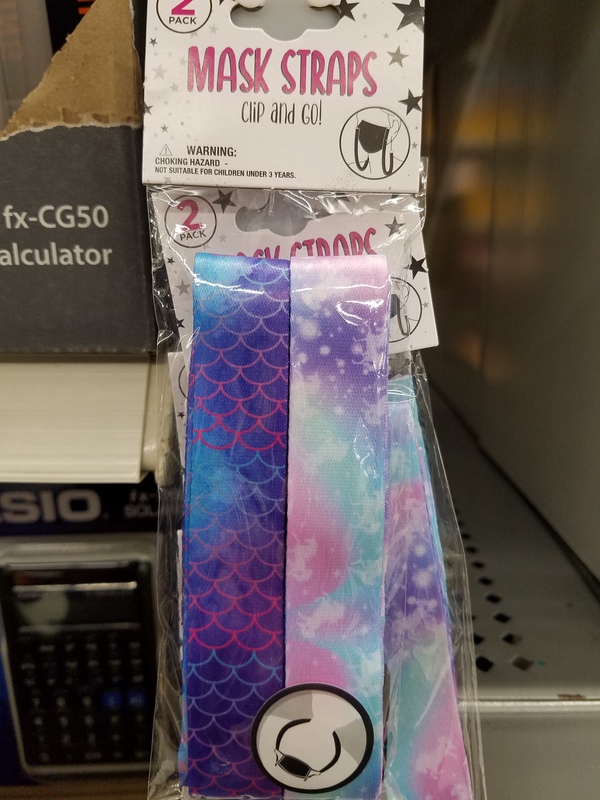
2021-01-28
Here are 5 pictures of various accessories for masks and hand sanitizer that began to appear in the last months of 2020 and early 2021 and have continued to the present (April 2021). Among them are mask "straps" and "chains" much like glasses strings for eyeglasses to keep a person's mask from accidentally falling off their face. Another picture shows a "posh" faux leather mask wristlet with a matching pouch for hand sanitizer. For those going on a airplane, a complete Corona safety travel kit including masks, antiseptic wipes, a headrest cover, and disposable gloves is produced by the company IFLY Smart. Finally, the emphasis on preventing potentially COVID-19 infected droplets from getting on someone's face lead to an entire pantheon of plastic shields attached to the wearer with bands or even hats of which this final picture is only one of many examples. These pictures show how businesses were quick to capitalize on the new problems, needs, and wants of a society having to accommodate Corona Accessories. It also shows how rapidly COVID was commercialized which is unusual for a significant event in the 21st century. Arguably, no single event in the 21st, and perhaps only World War II in the 20th, ever so thoroughly entered the public consumer culture like Corona. The prevalence of these products may also hint at the demand for them.
-
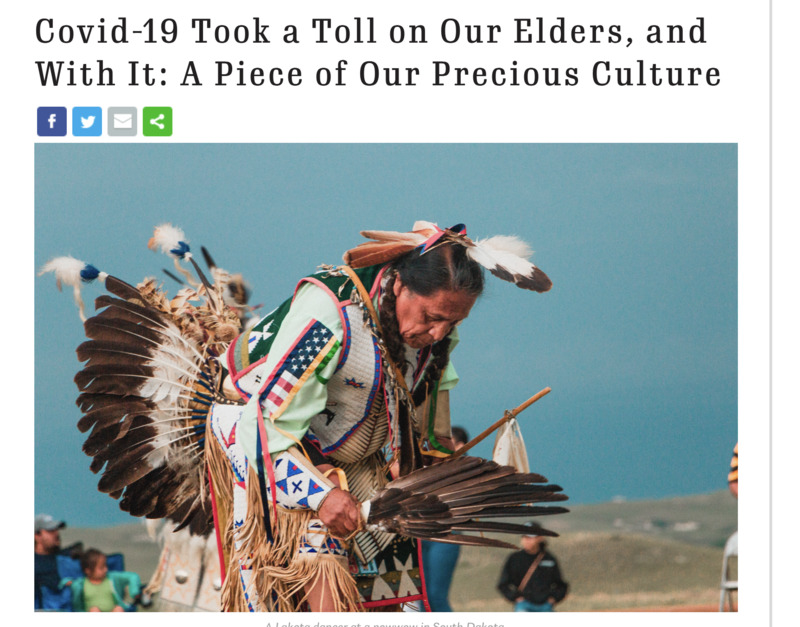
2021-04-02
Tribes across North America are losing their Elders and possibly their oral histories to COVID-19.
Indigenous Peoples, already faced with hardships such as poverty, medical resources, and food shortages, now endure the loss of these revered men and women. Although devastated by these hardships, the Pascua Yaqui tribe refuses to give up hope. They move forward continuing to celebrate their history and their people.
-
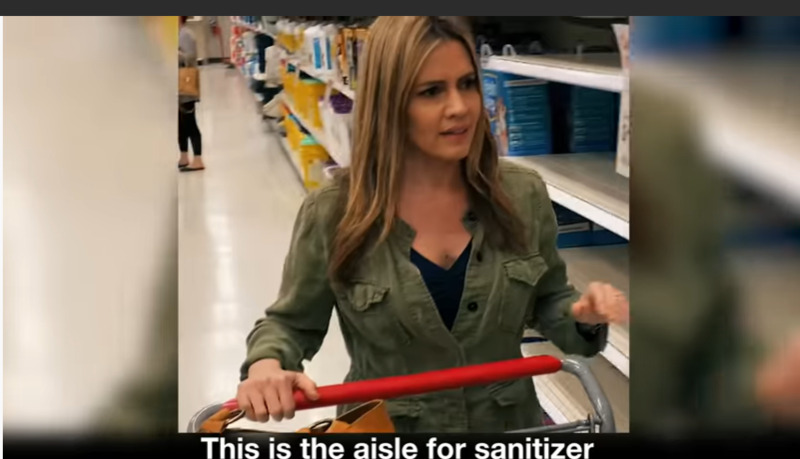
2021-04-05
The following music videos cover different aspects of the 2020 COVID-19 experience through a family's hilarious parodies of popular songs. In "Wash or Dang Hands" (March 2020), "End of the Roll" (April 8 2020), and "Quarantine (is Not Quiet Over)" (May 4 2020) the Holderness family uses humor to lift the spirits of people affected by increased sanitization, toilet paper shortages, and a longing for the pandemic to end. The videos take the everyday pandemic experiences of millions of people to produce funny lyrics that resonate with listeners because of their light-heartiness, and truthfulness. While all fun and games, these songs also help people to begin to crystalize their thoughts about Corona Culture and develop a better understanding of their experiences and the experiences of the world they live in. "Quarantine (is Not Quiet Over)" in particular serves as both a much shared expression of hope and a sort of prophecy for the future. It expresses the fatigue the world is experiencing due to the demands of COVID-19 and also expresses wishful hope (and doubt) that 2021 will see the end of the pandemic. These songs merit more study because of their immense cultural value during the Corona era.
-
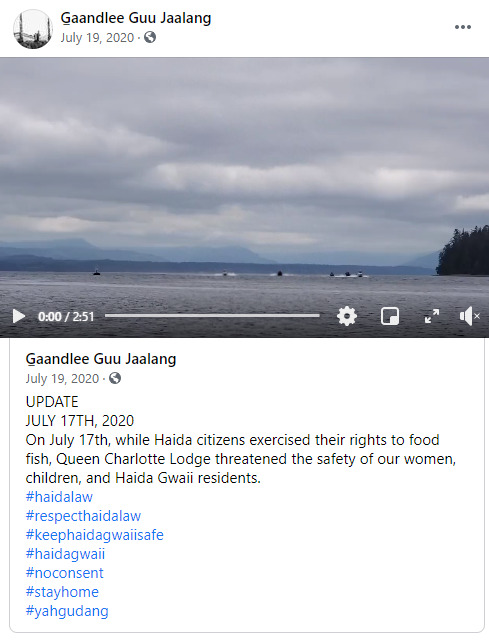
2020-07-19
QQueen Charlotte Lodge boats are filmed by Haida People racing through their waters and endangering traditional Haida fishing practices. When confronted by a Haida man, a QCL fishing boat captain informs them that these Indigenous People do not hold sovereignty over Haida Gwaii and further, accuses them of not managing their island properly. This is quite the irony considering the Haida have lived on this island for at least 6,000 years.
-
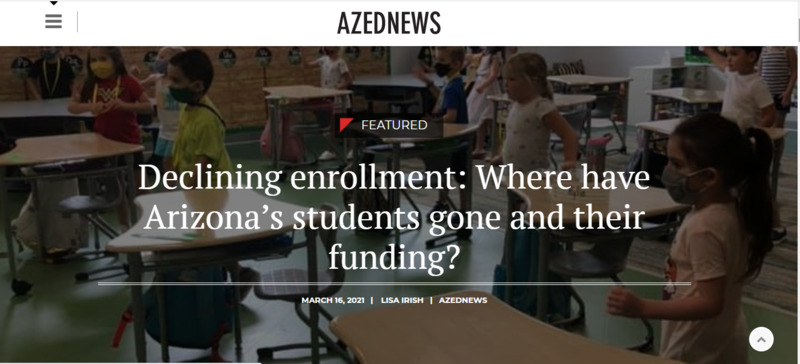
2021-03-16
This article highlights the declining enrollments of students in Arizona and their absence, so too does the funding disappear. According to the featured article, the combination of an approximate loss of 10% percent of the student population coupled with a drastic cut in the funding levels has significantly impacted the financial operations and organization of public school districts. The enrollment loss is mostly concentrated on the elementary levels, yet a notable loss of enrollment in high schools is of some concern. Declining enrollment not only affects the students' ability to develop important critical thinking and life skills, but in-person instruction should aid the student in recognizing the workload that comes with advanced degrees and education. Another option offers students the ability to learn through the hybrid instructional model.
-

2020-07-17
Haida woman Leeann Brown, reminds Queen Charlotte Lodge that they are not welcome on Haida Gwaii island during the pandemic. Many of the lodge’s boats are venturing too close to Haida fishing nets and traps which threatens their food supply. With such disregard to health of the Indigenous on the island, Brown explains how the Haida show their disagreement with lodge operations and reminds them that this land is sovereign to Haida Gwaii.
-
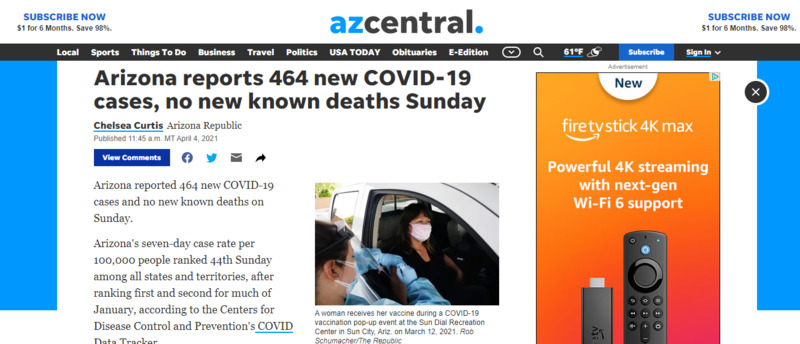
2021-04-04
Only six states reported lower COVID-19 cases than Arizona on Sunday, April 4. Though averages and daily counts for the state have trended down, the total cases and deaths are still among the worst.
-
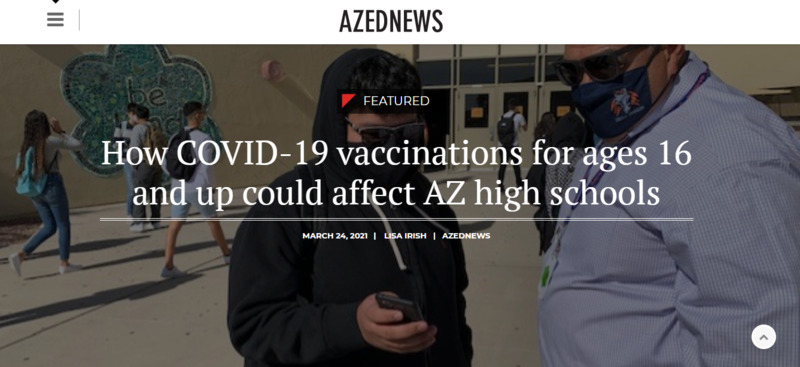
2021-03-24
(Monday, March 22, 2021) Gov. Doug Ducey announced that Arizonian's ages 16 and up would be eligible for COVID vaccines. In particular, the counties of Pima, Maricopa, and Yuma are interesting in administering the vaccines in an effort to produce "a positive impact on schools and our community." The statement from the governor comes after the executive order mandating that districts that are non deemed as "high transmission" counties. District leaders and health experts are hopeful that as more students and staff are vaccinated it will reduce transmission levels and ultimately produce an environment safe for all.
 2021-04-07
2021-04-07 2021-03-21
2021-03-21 2021-01-27
2021-01-27 2021-04-06
2021-04-06 2020
2020 2020-04-06
2020-04-06 2021-04-06
2021-04-06 2021-04-01
2021-04-01 2021-04-04
2021-04-04 2021-03-04
2021-03-04 2020-12-31
2020-12-31 2020-06-08
2020-06-08 2020-05-19
2020-05-19 2021-03-17
2021-03-17 2020-03-06
2020-03-06 2020-05
2020-05 2020-04-27
2020-04-27 2021-04-01
2021-04-01 2021-04-06
2021-04-06 2021-03-25
2021-03-25 2021-03-30
2021-03-30 2021-03-10
2021-03-10 2021-04-05
2021-04-05 2021-03-15
2021-03-15 2021-04-05
2021-04-05 2021-04-06
2021-04-06 2021-02-06
2021-02-06 2021-04-05
2021-04-05 2021-04-06
2021-04-06 03/30/2021
03/30/2021 03/30/2021
03/30/2021 2021-04-03
2021-04-03 04/03/2021
04/03/2021 2020-03-20
2020-03-20 2020-03-13T15:10
2020-03-13T15:10 2021-02-07
2021-02-07 2021-02-03
2021-02-03 2020-08-27
2020-08-27 2021-02-07
2021-02-07 2021-02-07
2021-02-07 2020-10-05
2020-10-05 2020-06-04
2020-06-04 2021-01-28
2021-01-28 2021-04-02
2021-04-02 2021-04-05
2021-04-05 2020-07-19
2020-07-19 2021-03-16
2021-03-16 2020-07-17
2020-07-17 2021-04-04
2021-04-04 2021-03-24
2021-03-24